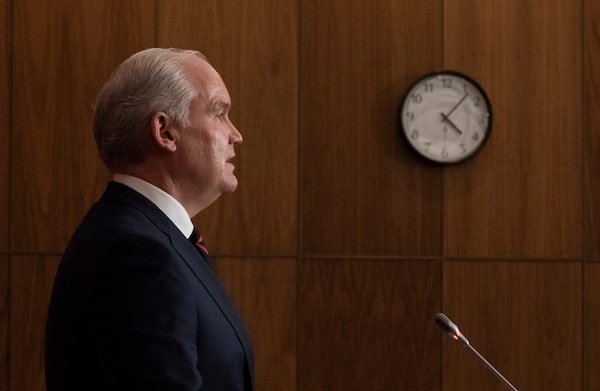
Conservative Leader Erin O’Toole will probably be able to suppress dissent within caucus and outside it, but internal divisions will dog him for months to come.Adrian Wyld/The Canadian Press
Erin O’Toole got through his first meeting with the Conservative caucus since the Sept. 20 election with his leadership intact, despite some grumblings. But he’s not out of the woods yet.
While Mr. O’Toole will probably be able to suppress dissent within caucus and outside it, internal divisions will dog him for months to come. After all, the party’s record of undermining any leader who doesn’t bring instant success is almost as old as the country.
Those disgruntled Conservatives who believe that victory is within their grasp in the next election, but only if they forcibly replace the existing leader with someone new, need a lesson in the history of their own party. It is a history of impatience, of quick fixes, of ill-thought-out strategies and of defeat. Do they really want to add another chapter to that sad tale?
The first game of musical chairs played out after the death in office of John A. Macdonald in 1891. His successor, John Abbott, was forced to resign due to ill health; Abbott’s successor, John Thompson, died in office. Thompson’s successor, Mackenzie Bowell, was forced out of office by his own cabinet; his successor, Charles Tupper, led a bitterly divided party to defeat at the hands of Liberal leader Wilfrid Laurier in 1896.
The next period of internecine strife lasted 22 years. After Conservative prime minister R.B. Bennett’s crushing defeat in 1935, the party eventually turned to Robert Manion, a former cabinet minister who was Catholic and who had married a French Canadian. That would be enough, party leaders calculated, to win over Quebec. It wasn’t.
After Manion’s defeat in the 1940 election, the men in the back rooms turned to Manitoba premier John Bracken, a Progressive. Changing the party’s name to Progressive Conservative and installing Bracken as leader would win over the West, they calculated. It didn’t.
After the 1945 defeat, the party jettisoned Bracken in favour of Ontario premier George Drew, believing that the prominent Central Canadian politician could secure both Ontario and Quebec. He couldn’t. After two election defeats and in ill health, Mr. Drew gave way to Saskatchewan MP John Diefenbaker. Senior Conservatives considered the populist renegade a stopgap. “After one election he would retire and the party could then find a younger, abler man,” party insider Dalton Camp later recollected. But Mr. Diefenbaker surprised everyone, including Mr. Camp, by leading the Tories to victory in the next three elections.
After 10 years of Mr. Diefenbaker’s erratic tenure, the party was once again in open rebellion. Mr. Camp helped oust Mr. Diefenbaker in favour of Nova Scotia premier Robert Stanfield, hoping the electorate craved sober, pragmatic government. It didn’t, preferring Pierre Trudeau instead. After Mr. Stanfield gave up, Alberta MP Joe Clark managed to lead the fractious party to victory in 1979, only to watch his minority government fall and be replaced by the reincarnated Trudeau Liberals. Lawyer and businessman Brian Mulroney forced Mr. Clark out of the leadership and won two terms in office. But after he left, the conservative movement fractured into two parties: the fatally weakened Progressive Conservatives and Western-based Reform.
Stephen Harper stitched the party back together again. After he led it to defeat in 2004, there were grumbles, but Mr. Harper learned from his mistakes and took the party to victory in 2006. Eleven years later, his successor, Andrew Scheer, inherited a united Conservative Party in opposition. But after he led it to defeat in 2019, the knives came back out and he was forced to resign. His successor is now trying to ward off the same fate.
Mr. O’Toole pulled the party toward a more centrist position in an effort to appeal to suburban voters in Greater Toronto and Vancouver. He failed. In the Sept. 20 election, the Conservatives lost seats in both regions.
Nonetheless, there is only one path to power for Conservatives: marrying rural old Canada to immigrant, suburban new Canada. Mr. O’Toole gets that. His strategy was sound; he just failed to execute. There is no better education in politics than to lose an election. This is Mr. O’Toole’s opportunity to learn and to grow.
But if the caucus and the party membership don’t give him that opportunity, if Mr. O’Toole becomes another Manion or Bracken or Clark or Scheer, then the Conservatives will deserve the fate that history says awaits them.
For subscribers: Get exclusive political news and analysis by signing up for the Politics Briefing.
 John Ibbitson
John Ibbitson